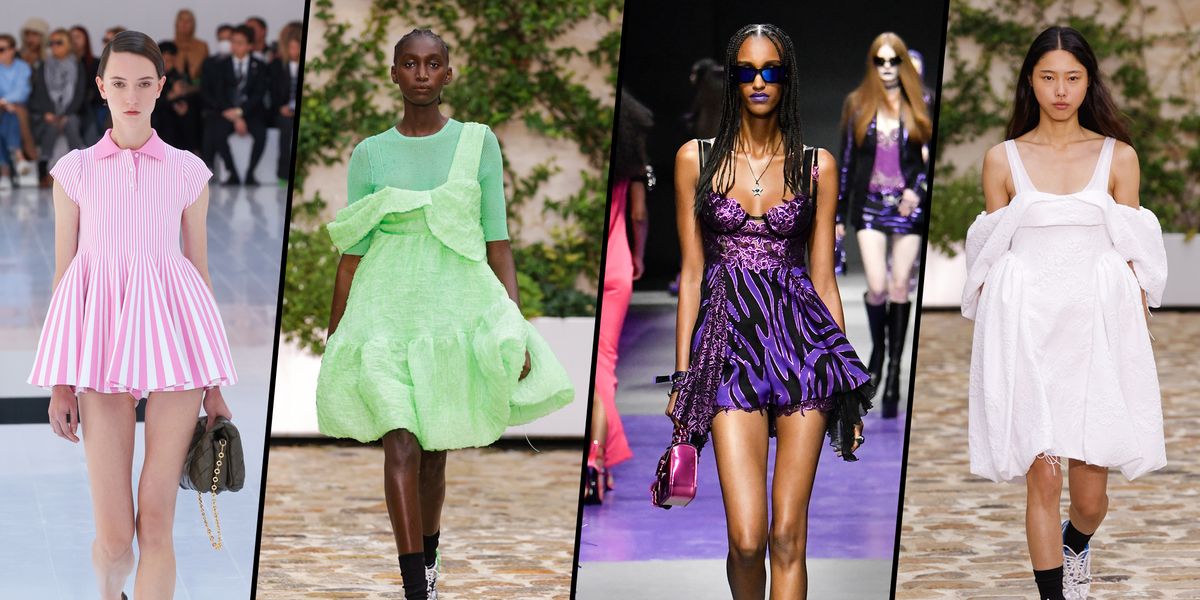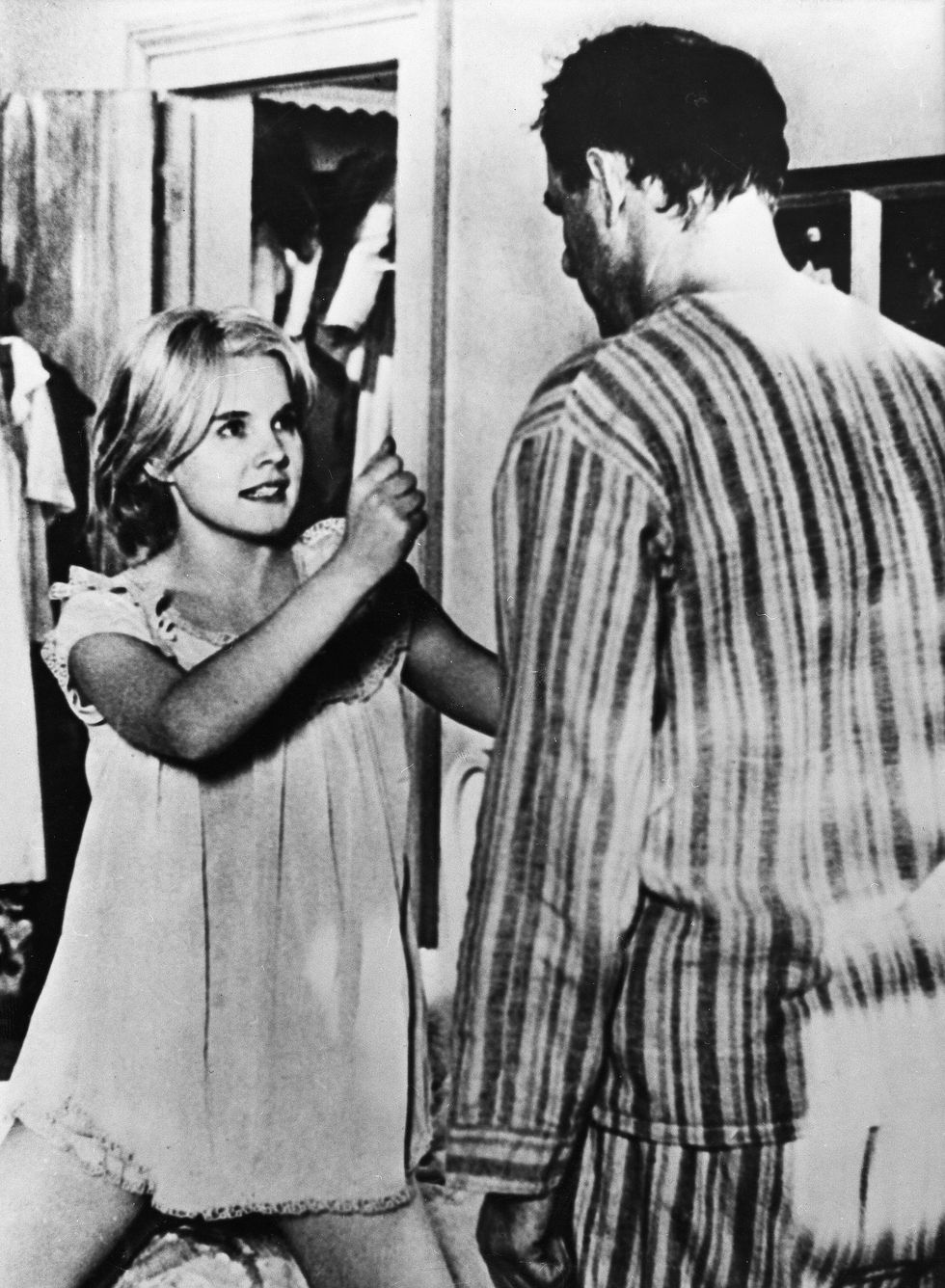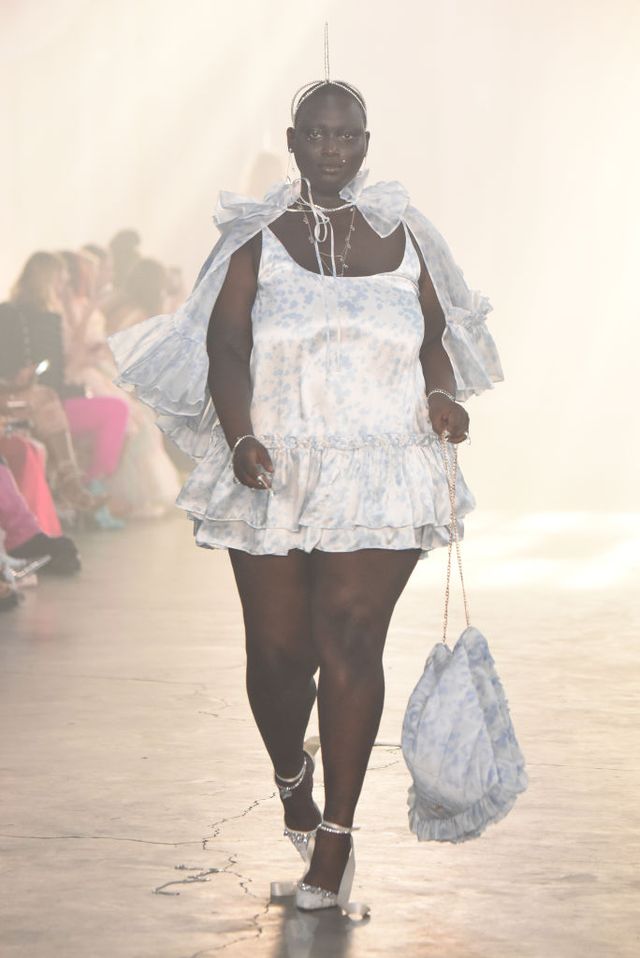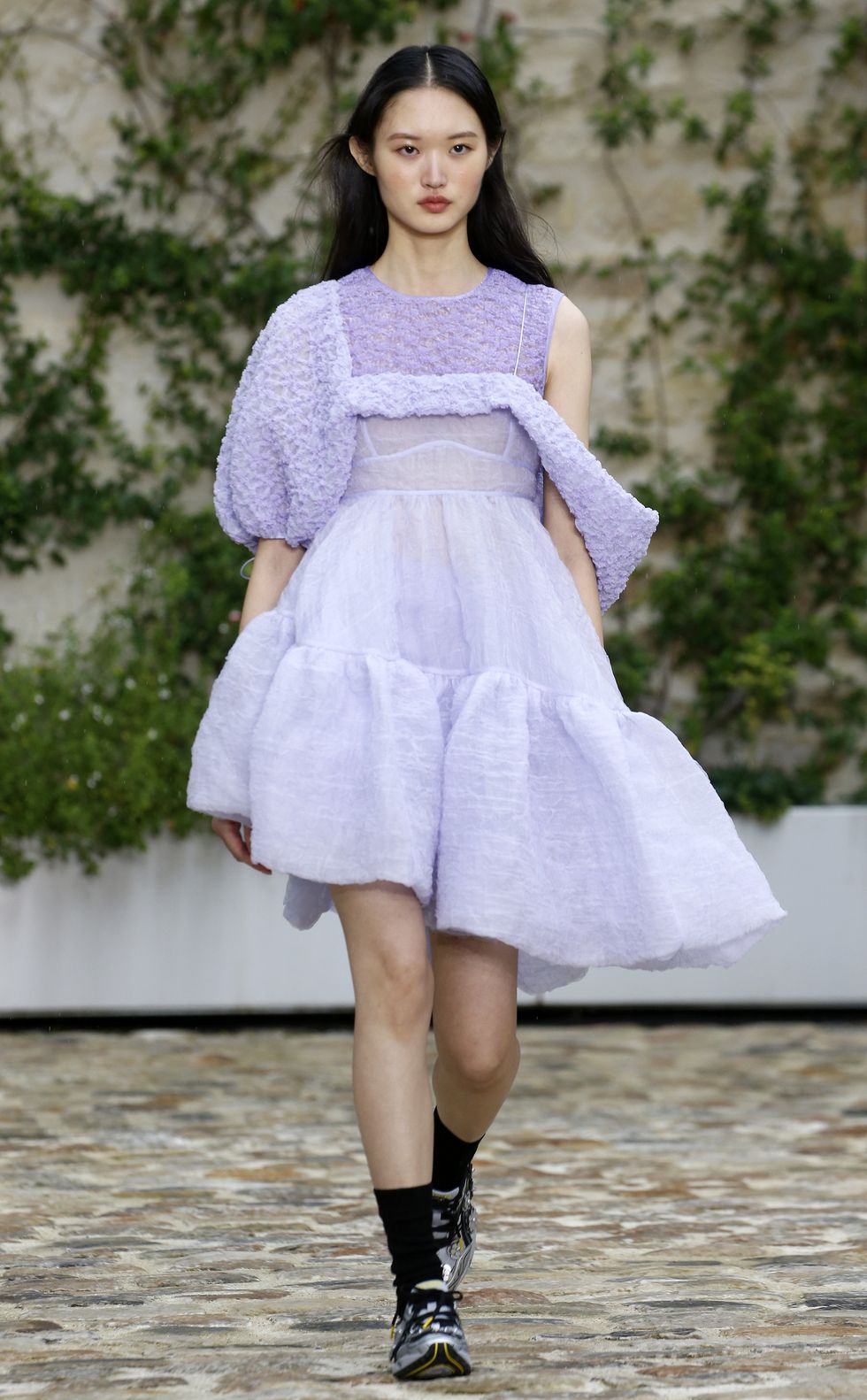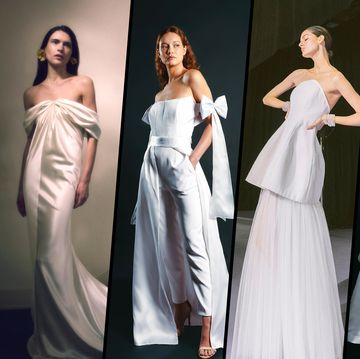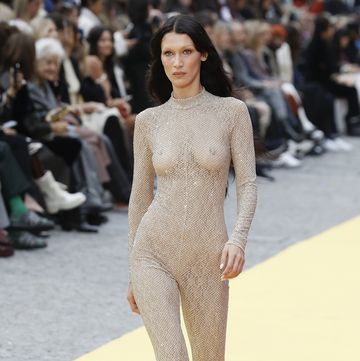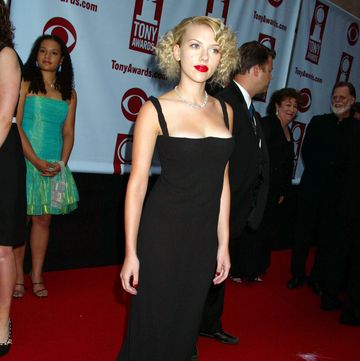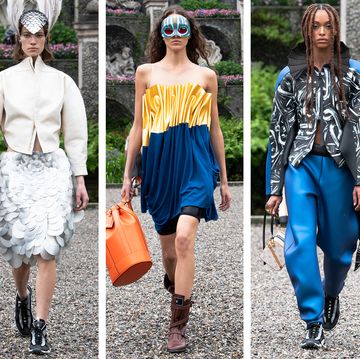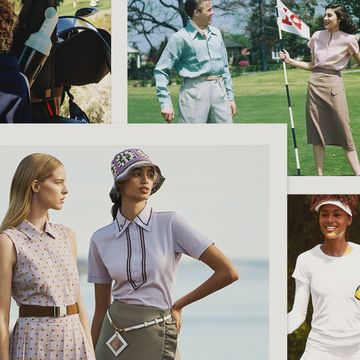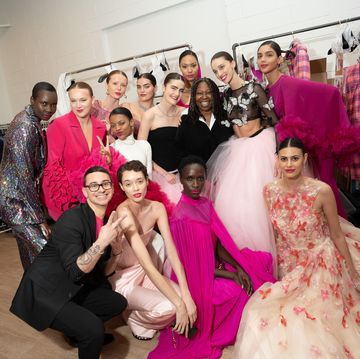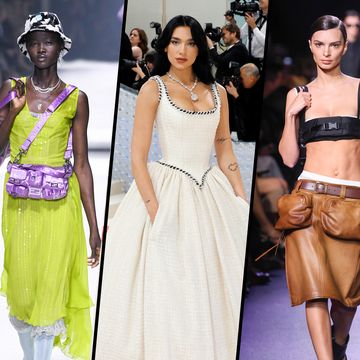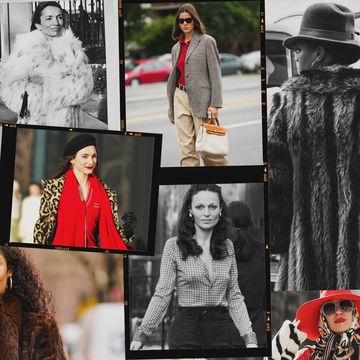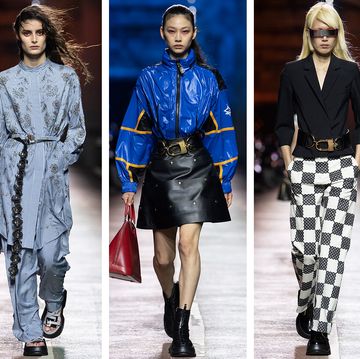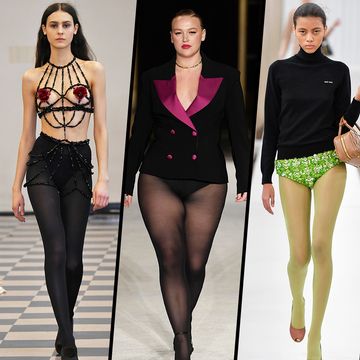The babydoll dress swept through the spring 2023 runways like no other silhouette. From Loewe’s dynamic striped wonders to Versace’s Courtney Love-esque little nothings, loose-fitting, pint-sizes dresses with major volume quickly became the garment on everyone’s minds. And then, there was M3GAN, 2023’s lifelike AI doll horror heroine who proudly sports a pale pink silk sateen minidress layered over a long-sleeve striped T-shirt.
Its triumphant return has everything to do with epic amounts of girlishness when it comes to aesthetics. But it’s also one of the most interesting dress silhouettes as it relates to feminism and how it was shaped over wartime, and later was reinvented by the punk scene. Perhaps no other dress has had so much to say throughout history as the babydoll.
According to Sarah Collins, professor and fashion historian at the Savannah College of Art and Design, the exact origin of the babydoll dress is unknown, but the term itself first appears in the 1912 novel Captain Martha Mary by Avery Abbott. In fact, the silhouette we recognize today is closely associated with lingerie in the 1930s. “While hemlines shorter than the knee still had not become acceptable for women in public, the hemlines could be a little more risqué in the bedroom,” says Collins. “They became widely popular in the 1940s after American designer Sylvia Pedlar of Iris Lingerie made lingerie shorter in response to the L-85 wartime rationing of fabric. It is said that she personally hated the term babydoll. Legend has the name coming from the 1956 black comedy Baby Doll, which is based on a play by Tennessee Williams. In the movie, Carroll Baker plays a 19-year-old virgin, ‘Baby Doll’ Meighan, who is married to an older man. They are waiting until her 20th birthday to consummate the marriage. She wears babydoll-style lingerie and sleeps in a crib.”
Back then, the babydoll was firmly filtered through an obvious male gaze, but high fashion also adopted the style just a few years later. “[Cristóbal] Balenciaga popularized the silhouette for day and eveningwear in 1958 with his trapeze dress. After so many years of the New Look silhouette, the babydoll felt fresh and youthful. Simultaneously, Hubert de Givenchy also amplified the trend with his sack dresses. These styles would lead to the super-short A-line dresses of the 1960s, where Twiggy embodied the mix of little girl innocence with newfound sexual freedom for women.”
The ’60s may have also been the most pivotal moment for the silhouette simply by nature. “Once the babydoll transitions into the 1960s and becomes shorter and shorter, it becomes even more risqué,” says Collins. The look is one that represents an uprising of feminism and also ties into subcultures that span across generations into the ’90s. Collins adds: “Socially, at that time, the youth and women in particular were experiencing sexual freedom and were busy throwing off stuffy behavioral rules. With the Riot Grrrl look of the 1990s, the babydoll once again becomes associated with a woman’s sexuality and rebellion. Courtney Love popularized this look where the bad girl is dressed in the markers of innocence juxtaposing society’s expectations of a good girl with this sex, drugs, and rock ‘n’ roll persona.”
Today, the fact that the aesthetic is trending speaks volumes about a new generation embracing the coquette aesthetic all over social media—as well as those who are putting a fresh narrative on it, like Cecilie Bahnsen, Selkie, and LoveShackFancy, to name just a few. Women are reclaiming the narrative so that the dress doesn’t feel sexy or fetishized, but rather, something much dynamic. “I think women are increasingly being drawn towards clothes that make them feel feminine, effortless, and empowered all at once,” says Bahnsen. For her spring/summer 2023 collection, for example, the designer hosted her second show in Paris and filled it to the brim with a manifestation of puffy, saccharine gowns that represented a new take on the babydoll. There were lilac asymmetric shoulder renditions, Kelly green crinkled puffs, and angelic white off-the-shoulder minis. To be clear, Bahnsen has been leading the way for fashion insiders’ favorite oversized babydoll dresses since she founded her line in 2015, and she’s only getting better at it as the years go on. “There is a certain freedom in wearing a cloud-like silhouette that gives you confidence,” she adds. “I also think it’s about having fun with how you put yourself together—not everything has to be so serious. It’s hard to put on a big poofy dress and not smile.”
In 2023, a new generation of emerging designers is also helping to usher in a new sentiment about the babydoll dress, and specifically taking inspiration from nostalgia and the heritage of being a woman. Many are looking back to their own female relatives. Also, the babydoll is no longer reserved for special occasions: the dress itself is the occasion and the wearer is the cause for celebration. Tessa Thompson of Tessa Fay, for example, takes inspiration from the interiors in her grandmother’s house and upcycles salvaged drapery to create, “the most perfect ‘throw-and-go’ babydoll dress you ever did see,” as she calls them. She designs and makes everything with her grandmother, and the babydoll was the first item she was ever taught how to sew. “It’s dressing for the girls,” she says. “An alternate route to feeling feminine and flirty that’s not so body-focused. It stands out in a space crowded with shapewear and Y2K street style, but still caters to the nostalgia that every generation can relate to. It is unique in that it is a silhouette that can be worn year-round and offers unlimited styling versatility. You can make it frilly, rocker, utilitarian, retro, any “whatever-core” you can think of, and it works. It has survived the trend cycle time and again. It’s simply a classic.”
Likewise, Zepherina’s Renea LaRiviere is inspired to create modern, feminine heirlooms to be passed down for generations. Her mini silk taffeta party dresses done in the familiar babydoll style are the unequivocal answer to dressing up for dressing up’s sake. “I always go back to my mother and her three sisters in the late ’60s and ’70s,” she says. “They always wore their Sunday best to church. I am very inspired by what they would where to go to certain events and ceremonies. I also love the idea of occasion dressing and how everything a person wears can get a bit more volume and added drama for an event.”
People who often wear the babydoll also feel a strong connection to the shared sisterhood of the piece, as well as the nostalgic vibes: “When I wear the silhouette, not only do I feel confident, but I feel in touch with my feminine side,” says Juliana Shun, 23, a stylist and accessories lead for a thrift store who frequently wears the look. She dresses it down with loafers or dresses it up with knee-high platform boots. “I grew up wearing dresses, so in a way, it reminds me of my childhood.”
Scrolling through TikTok, it’s never been easier to see expressive dressing that puts the personality of the babydoll dress on full display. Case in point: part of what lends Bahnsen’s dresses to feeling ultimately more wearable than many of the other frilly babydoll silhouettes is also the styling. Rather than pair the super frills with platform heels and fishnets, you’ll see the Danish designer’s pieces worn with sneakers or even layered over loose pants both on the runway and on the streets. “I think a lot about the idea of ‘everyday couture’ and how our pieces are designed to be worn, not to be precious about,” Bahnsen says. “There is something really interesting about the juxtaposition of hyper feminine details with more utilitarian pieces that continues to inspire me.”
Perhaps in an era where fashion is experiencing great change, spearheaded by post-pandemic times and a looming recession, the babydoll is one answer. “Fashion has long reflected the zeitgeist of its time,” says Collins. “By studying a woman’s dress, you can see what role she plays. Style is ultimately about self-expression, so when women are rebelling against expectations or retreating into prescribed roles, it shows through their clothing.” The babydoll’s fearless reclamation as in-your-face feminine in 2023—without catering to the male gaze—makes it all the more compelling.

